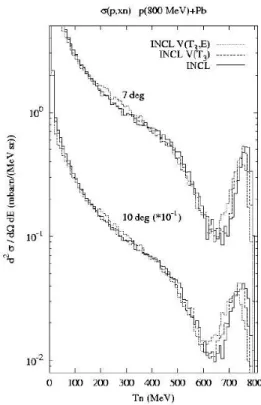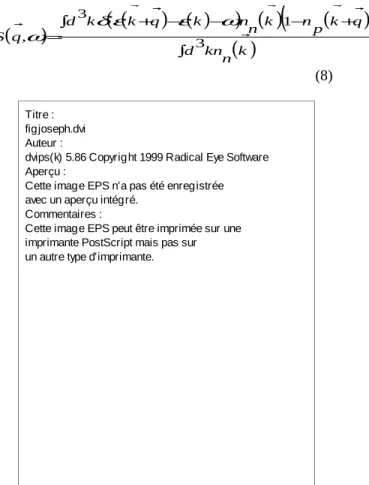Recent Progress of the Liège Intranuclear Cascade Model
J. Cugnon+, T. Aoust+,*, P. Henrotte+ and B. Van den Bossche+
+University of Liège, Physics Department, Institute of Physics B.5, Sart Tilman, B-4000 LIEGE 1, Belgium
*SCK-CEN, Boeretang 200, B-2400 MOL, Belgium
e-mail: cugnon@plasma.theo.phys.ulg.ac.be
Abstract- Recent improvements of the Liège intranuclear cascade model are presented. They include the
isospin- and momentum-dependence of the nuclear mean field and the modification of the treatment of the Pauli blocking at low incident energy. The effects on the description of spallation reactions are analyzed. In particular, it is shown that the predictions for the quasi-elastic peaks and for incident energy down to 40MeV are substantially improved. Implications on particle transport codes are briefly discussed.
I. INTRODUCTION
The Liège intranuclear cascade (INC) model for nucleon-induced spallation reactions has recently evolved into a rather elaborate version, designated as INCL4.0. It is described in Ref.1. The most decisive improvements compared to the previous version2 are the introduction of smooth initial density distributions, in concordance with electron scattering data, and the implementation of a consistent treatment of the Pauli blocking, which alleviates the unphysical aspects of the usual statistical treatment. In addition, further improvements have been added, concerning pion dynamics and the accommodation of light composites as incident particles. The INCL4 model emerged from an attempt of the HINDAS collaboration3 to improve the INC description of spallation reactions in the 200 MeV-2 GeV range. It has been included recently in the LAHET code system and will soon be introduced in the MCNPX transport code. In Refs.1,4, the INCL4.0 model is shown to be quite successful in the description of a large body of experimental data, in the 100 MeV-2 GeV incident energy range, including reaction cross-sections, neutron and proton differential cross-sections, residue production cross-sections and residue recoil energy distributions. We report here on the later developments of the Liège INC model. They bear on the isospin and momentum dependences of the nuclear mean field, on the analysis of the quasi-elastic scattering and on the validity of the INC approach at low energy.
II. ISOSPIN DEPENDENCE OF THE MEAN FIELD In INCL4.0, the target nucleons are moving in a nuclear potential well, which is the same for protons and neutrons1. Also, the Fermi momentum is taken the same for both species. As a consequence, they have the same separation energy. In order to account for the isospin dependence of the mean field, we introduce potential wells of different depths Vp0 and Vn0. Similarly, different Fermi momenta should be introduced, as well. The latter can be determined easily by using momentum distributions corresponding to uniform Fermi spheres and by requiring the total density (in the center of the nucleus) to be equal to the phenomenological value ρ0. One thus has
( ) ( )
{
}
, 31 , 0 3 3 2 3ρ
π
+ = = n F p F n F p F k k NZ k k (1) where Z and N are the target proton and neutron numbers, respectively. These two relations univoquely determine the values of the Fermi momenta.The depths of the potentials Vp0 and Vn0 are taken as follows. We first ask the chemical potential to be the same for both neutrons and protons:
(
)
( )
,
2
2
0 2 0 2 n n F p p FV
M
k
V
M
k
−
=
−
(2)which expresses approximately the β-stability of the target. We also require that the mean value of the potentials Vp0 and Vn0 is the same (45 MeV) as in the previous version of the model, which did not introduce different potentials for neutrons and protons. The isospin dependence of the potentials is numerically close to the one of the phenomenological Lane potential5.
Analysis of the effect of the isospin dependence is postponed until the next section.
III. MOMENTUM DEPENDENCE OF THE MEAN FIELD
The momentum dependence of the mean field is a well-established phenomenological feature, which is also supported by theoretical arguments6,7. For on-shell particles (only these ones can be handled by quasi-classical models such as INC), a momentum dependence is equivalent to an energy dependence. The dispersion relation for nucleons (i = n,p) then takes the form
( )
.
2
2 2 i i iM
V
E
k
E
=
−
(3)We try to keep the description as close as possible to phenomenological knowledge, assuming a linear dependence for the potentials Vi
( )
,
i i i i iE
E
V
=
α
−
β
(4) as long as Vi is positive, which happens when Ei is smaller than ~ 200 MeV. Beyond this value, we keep Vi = 0, which seems reasonable.According to Ref.8, we choose βn = βp = 0.23. The quantities αi are determined, as above, by requiring the equality of the chemical potentials
( ) ( )
p F p n F nk
E
k
E
=
(5)The isospin dependence is contained in the αi’s.
The implementation of energy conservation requires now the equality of mass + kinetic + potential energy. For a
N
1N
2→
N
3N
4 reaction, one has,
) 4 ( 4 4 ) 3 ( 3 3 ) 2 ( 2 2 ) 1 ( 1 1 V E E V E E V E E V E E + + + = + + + (6) where the Ei’s are the mass + kinetic energies. In previous versions of the Liège INC model, all Vi’s were equal and therefore neglected. Now, the final energies are determined iteratively in the c.m. frame of the colliding pair.In Fig. 1, we compare the predictions of the Liège INC model (here for INCL3, but the effects of the isospin and momentum dependences of the potential are similar for INCL4.0), for the neutron inclusive cross-section in proton-induced reactions. The differences are rather small. However, there is a systematic shift of the quasi-elastic peak toward smaller energy when going from a unique potential to a isospin-dependent one and to a isopin- and momentum-dependent one. Although this
Fig. 1. Neutron production cross-section at two angles for p(800 MeV) + 208Pb reactions. Comparison between predictions of INCL3 model with a constant potential
(full lines), isospin-dependent potential (dashed lines) and isospin- and momentum-dependent potential (dotted lines).
diminishes a systematic deficiency of the INCL4 model (see Ref.1), the effect is not sufficient to drive the location of the quasi-elastic peak at the right place.
The effect on particle multiplicities is exhibited in Table 1. The introduction of isospin-dependent nuclear potentials lowers the average multiplicity of neutrons emitted in the cascade stage and slightly increases the corresponding proton multiplicities. This in an improvement compared to the results of INCL4.01. In our opinion, this results from the fact that target neutrons (protons) are now sitting, on the average, lower (higher) compared to the Fermi energy. As a secondary effect, the excitation energy has slightly increased, leading to more or less constant neutron and proton multiplicities. The further introduction of the momentum dependence slightly increases the trends, leading ultimately to a slight increase of the nucleon multiplicity. We are currently studying these effects at lower incident energy.
TABLE I. Neutron and proton multiplicities in p (800 MeV) + 208Pb reactions. Comparison between our predictions for three choices of the mean field. The Dresner evaporation code9 has been coupled to the INCL3.
Multiplicity Constant
Potential IsospinDependent potential Full dependence ncasc 2.702 2.530 2.301 nevap 13.731 13.969 14.452 n 16.433 16.499 16.753 pcasc 2.051 2.146 2.087 pevap 1.262 1.252 1.316 p 3.314 3.398 3.403
IV. QUASI-ELASTIC SCATTERING
Although the INCL4.0 model gives a very good description of spallation reactions, it suffers from some small but definite weaknesses. The most striking one is the bad location of quasi-elastic (charge-exchange) peak at forward angles in (p,n) reactions, whereas the peak comes out to the right place in (p,p) reactions. As these quasi-elastic peaks are largely dominated by the single scattering component2, we decided to study the latter by analytical methods. Using a Fermi gas description for the target and assuming that the nucleon-nucleon transition
matrix is smoothly varying with kinematical variables, the nucleon production cross-section is given by10
( )
(
,
)
,
0 2E
E
q
S
d
d
A
dE
d
d
Ω
=
effΩ
NN−
σ
σ
(7) where E0 is the incident energy, andq
the momentum transfer. The quantity( )
NN
d
d
Ω
σ
is the relevant nucleon-nucleon cross-section (direct elastic for (p,p) reactions and charge-exchange scattering for (p,n) reactions). The quantity Aeff is the effective number of target nucleons, i.e. those leading to single-scattering only. It is usually computed from Glauber theory. Finally the quantityS
( )
q
,
ω
is the response function for nuclear matter. For (p,n) reactions, it reads(
)
(
(
)
( )
) ( )
(
(
)
)
( )
, 3 1 3 , ∫ ∫ + − − − + = k n kn d q k p n k n n k q k k d q S ω δε ε ω (8) Titre : figjoseph.dvi Auteur : dvips(k) 5.86 Copyright 1999 Radical Eye Software Aperçu : Cette image EPS n'a pas été enregistrée avec un aperçu intégré. Commentaires : Cette image EPS peut être imprimée sur une imprimante PostScript mais pas sur un autre type d'imprimante.Fig. 2. Comparison between the predictions of the analytic model described by Eq. (7) for the quasi-elastic contributions with the experimental data of Refs.11,12. The panels refer to neutron (top) and proton (bottom) production in p (800 MeV) + 208Pb reactions.
where
n
( )
k
i
is the occupation number of state
k
for species i (= p,n). The quantityε
( )
k
is the single-particle energy of a nucleon of momentumk
.In the eighties, the quasi-elastic (p,p) scattering has received much attention10,13. The main conclusion of this investigation was that the above approach could not explain the size and the proper location of the peak. In Refs.10,14, it was argued that the response of semi-infinite matter should be substituted to S into Eq. (7). Here, we reinvestigate the problem, using Eqs. (7,8) with a better description of the single-particle spectrum and the introduction of asymmetric nuclear matter. The results of this analysis are in keeping with the INC results of Ref.1: the location of the peak and the integrated cross-sections come out reasonably well for (p,p) reactions; on the other hand, the center of the peak is still situated at a too high energy (these statements are correct except for very small angles, where the peak is theoretically too narrow). This situation is illustrated in Fig. 2 for a typical case. In our opinion, the discrepancy between theory and experiment for (p,n) reactions may arise either from using zero-width single-particle excitations or from the neglect of collective effects.
V. LOW-ENERGY LIMIT OF VALIDITY OF INCL The theoretical limit of validity is usually determined by requiring that successive nucleon-nucleon collisions are well separated (in space), or more or less equivalently that the de Broglie wavelength of the incident nucleon is small compared to the average distance between neighboring nucleons. This condition is barely fulfilled when the incident energy reaches ~ 200 MeV. It is of course better and better fulfilled when the incident energy increases. One has to keep in mind that the separability of secondary collisions is far from being ensured on the basis of the criterion above.
Occasionally, the INC model has been applied, with some success, at incident energy lower than the theoretical limit of 200 MeV15. In a recent work13, the relevance of the INC approach at low incident energy has
been examined, basically by a systematic comparison of the INCL predictions (here INCL3) and the available experimental data for proton and neutron double differential cross-sections. The conclusions of this investigation are the following: (i) the total reaction cross-sections are underestimated, as usual with the INCL3 version, which neglects the smoothness of the nuclear surface; (ii) the predicted energy and angular distributions compare reasonably well with experiment, provided a strict Pauli blocking (instead of the statistically implemented one, see Ref. 1) is used; (iii) better results are obtained when the Pauli blocking is strictly enforced for the first nucleon-nucleon collision and statistically enforced for the following collisions. The last remark has prompted a complete analysis of the implementation of the Pauli blocking in the INC model. The results will be published elsewhere17, but it turns out that the blocking of soft collisions is rather unstable, which raises the relevance of the description in terms of collisions for soft perturbations of the motion of the incident particles in INCL4, the soft collisions are neglected1.
If INCL3 (or INCL4.0) is used as a model of collisions in the impact parameter range (taking the total cross-section from experiment), its predictions for neutron double differential cross-sections are rather good down to ~ 40-50 MeV incident energy. An illustration is given by Fig. 3. One has however to keep in mind that composite production is neglected by this model. Experimentally, this process becomes comparatively more and more important as incident energy decreases.
VI. CONCLUSION
We have analyzed three issues related to the physics of the INCL4 version of the Liège cascade model. The first one deals with the effect of the isospin and momentum dependence of the mean field. The effect is
Titre : fig3b.eps Auteur : HIGZ Version 1.26/04 Aperçu : Cette image EPS n'a pas été enregistrée avec un aperçu intégré. Commentaires : Cette image EPS peut être imprimée sur une imprimante PostScript mais pas sur un autre type d'imprimante.
Fig. 3. Comparison of the predictions of the INCL model with experimental data18 for neutron production in p (80 MeV) + 208Pb reactions.
rather small except perhaps at low incident energy. The second issue bears on the intensity and location of the quasi-elastic peak. Both INCL4.0 and analytical studies indicate that the usual single-scattering approximation combined with the Fermi gas picture is sufficient to explain the (p,p) data, while it predicts the location of the peak at too high energy in (p,n) reactions. A possible explanation seems to lie outside the single-particle picture. Finally, we indicate that the INCL model works reasonably well down to a 40-50 MeV incident energy, in spite of the theoretical expectancy. We think that these conclusions are not typical of the INCL model but apply more generally to the INC approach itself.
ACKNOWLEDGMENTS
We acknowledge the financial support of the European Union HINDAS collaboration (EU contract n° FIKW CT-2000-00031).
REFERENCES
1. A. BOUDARD, J. CUGNON, S. LERAY, C. VOLANT, Phys. Rev., C66, 044615 (2002).
2. J. CUGNON, C. VOLANT, S. VUILLIER, Nucl. Phys., A620, 475(1997).
3. A. KONING et al., J. Nucl. Sc. Tech. Suppl., 2, 1161 (2002).
4. A. BOUDARD, J. CUGNON, S. LERAY, C. VOLANT, J. Nucl. Sc. Tech. Suppl., 2, 762 (2002). 5. A. M. LANE, Nucl. Phys., 35, 676 (1962).
6. C. MAHAUX, R. SARTOR, Adv. Nucl. Phys., 20, 1 (1991).
7. E. GADIOLI, P.E. HODGSON, Pre-equilibrium
Nuclear Reactions, Clarendon Press, Oxford, (1992).
8. P. E. HODGSON, The Nucleon Optical Model, World Scientific, Singapore, (1994).
9. L. DRESNER, Oak Ridge report ORNL-TM-196, (1962).
10. H. ESBENSEN, G.F. BERTSCH, Phys. Rev., C34, 1419 (1986).
11. X. LEDOUX et al., Phys. Rev. Lett., 82, 4412 (1999). 12. R. E. CHRIEN et al., Phys. Rev., C21, 1014 (1980). 13. D. L. PROUT et al., Phys. Rev., C52, 228 (1985). 14. H. ESBENSEN, G.F. BERTSCH, Ann. Phys. (N.Y.),
157, 255 (1984).
15. H. W. BERTINI, Phys. Rev., C5, 2118 (1972). 16. J. CUGNON, P. HENROTTE, Eur. Phys. J., A16,
393 (2003).
17. P. HENROTTE, to be published.


